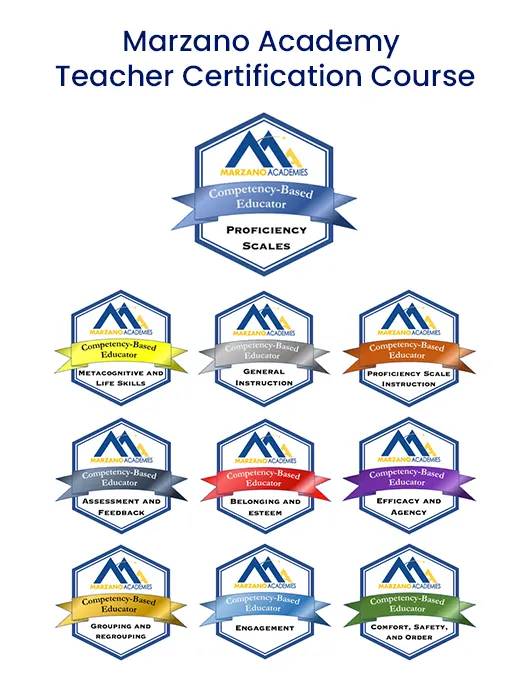Description
Marzano Academies Competency-Based Instructional Model Micro-Credentialing Pathways
-
Evidence-based material by Dr. Bob Marzano
- Dr. Marzano has created an instructional model for Competency-based classrooms based on his 50 years of research. He has identified the nuances that make a CBE classroom different from a traditional classroom, provided detailed strategies a teacher can use today, and what measures they can use to determine if they are having the desired impact on their learners’ behaviors and dispositions that lead to higher levels of achievement.
-
Flexible (personalized) –
- Various Interactive Methods
- The courses are available on your schedule. Complete them as you feel you have the capacity. Interact with the material at your convenience.
- Support
- Access to office hours with Marzano Academies’ implementation Specialists.
- During these sessions, we will:
- Break down the evidence-based elements and strategies further.
- Discuss implementation strategies
- Answer specific questions about using the elements and strategies in your classroom.
-
Fulfillment
- Opportunities to become demonstration classrooms. Become part of the professional network of Marzano Academies Competency-Based Educators.
- earn credentials you can use in your emails and social media to share your professional accomplishments.
- Receive direct feedback from the Marzano Academies Implementation Specialists following the submission of your work.
- Improve something meaningful to you – your career. Opportunities to strengthen current skills, use them in new ways, and add more to your tool belt to continuously improve in what we do. While no one is ever perfect, our learners always deserve better than good enough.
How does it work?
The Marzano Academies’ Instructional model comprises four Domains, ten Design Areas, and 49 Elements. To earn the Design Area badge, you must complete both Course 1 and Course 2. Educators will access all courses through the Marzano Academies’ portal.
Element Credentialing:
In the Elemental Level Credentialing Courses and as part of the Design Area Badging and complete certification courses, you begin building the foundational knowledge of the elements associated. This is done by interacting with the Competency-Based Education Folio Series. You will gather information regarding the research behind the Elements and learn about different strategies you can implement to impact learners. Hence, they show the desired behaviors and dispositions that lead to increased learning and achievement. After gathering the information, you take an assessment that asks you to recall the acquired foundational knowledge of the element that was the focus of the folio. This earns you the credential for the individual element of the instructional model.
Design Area Badge:
If you wish to continue to earn the badge for one of the ten design areas, you will apply the knowledge gained in the element credentialing course by reviewing teacher-based scenarios, taking a self-assessment, and uploading a narrative and video describing how you meet the goals of the Design Area in your classroom. When you have finished the course, you will earn a badge for that Design Area.
Full Certification:
You can continue to earn the badge in each of the ten Design Areas to become a certified competency teacher.
Credentialing Course Descriptions
Proficiency Scales Badge
The course for Design Area I will help teachers build the foundational knowledge of creating proficiency scales and communicating them with students. The teacher will study the elements of the instructional model dealing with providing proficiency scales, tracking student progress, and celebrating student success.
Ia – Providing Proficiency Scale Element Credential: Learn about the structure of proficiency scales and how to use them with learners.
Ib – Tracking Student Progress Element Credential: An important part of the cycle of learning, assessment, and further learning is awareness of the progress students are making toward specific learning goals.
Ic – Celebrating Success Element Crednetial: An underlying desire to succeed coupled with being recognized for success helps students stay motivated to continue learning and growing.
Assessment and Feedback
The course for Design Area II will help teachers construct and administer assessments that accurately measure students’ status on proficiency scales and help students understand the relationship between their scores on assessments and their overall status on a scale. The teacher will study the elements of the instructional model dealing with Using Obtrusive Assessments, using student-centered assessments, using unobtrusive assessments, and generating a current summative score.
IIa and IIc – Obtrusive and Unobtrusive Assessment Element Credential: Assessments in a competency-based classroom focus on a single dimension and that dimension is described by a single proficiency scale.
IIb – Student-Centered Assessments Element Credential: Student-centered assessments are those that maximize students’ input into the design and scoring of assessments.
Proficiency Scale Instruction
The course for Design Area III will help teachers introduce and initially reinforce the content from proficiency scales. The teacher will study the elements of the instructional model dealing with chunking, progressing, recording and representing content. Teachers will also study using structured practice, examining similarities and differences, engaging student in cognitively complex tasks, generating and defending claims.
IIIa and IIIb and IIIc – Direct Active Instruction Element Credential: We begin instruction by using the content in proficiency scales to proactively plan to chunk, process, and record or represent the information to help our learners acquire the foundational knowledge.
IIId and IIIe – Practice Skills and Go Deeper with the Content Element Credential: After learners have acquired the foundational knowledge though active direct instruction, we plan for how they will practice the procedural knowledge and deepen their understanding of concepts.
IIIf and IIIg – Complex Tasks and Generating and Defending Claims Element Credential: What are cognitivelty complex tasks and how d o we ensure we are getting our learners to this level of discovery when they ahve the acquired foundational knowledge.
General Instruction
The course for Design Area IV will help teachers design and execute instructional activities that help students refresh, revise, and integrate their knowledge on specific content. The teacher will study the elements of the instructional model dealing with reviewing content, revising knowledge, examining and correcting errors, highlighting critical information, previewing content, stimulating elaborative inferences, and extending learning through homework.
IVa and IVb and IVc – Reviewing Content Revising Knowledge Element Credential: When learners evidence indicates they have errors, we need to be ready to help them examine and correct their errors.
IVd and IVe – Previewing and Highlighting Element Credential: Sometimes learners need the critical information highlighted in order to see it.
IVf and IVg – Elaborating and Extending Through Homework Element Credential: As the name implies, these types of inferences elaborate on content that has been previously learned.
Grouping and Regrouping
The course for Design Area V will help teachers understand why and how to group students for effective learning. In a CBE classroom, this requires the teacher to think in terms of how to best help this particular student with this particular content which will mean the teacher has several groups of students at the same time. The teacher will study the elements of the instructional model dealing with supporting group interactions, supporting group transitions, providing group support.
Engagement
The course for Design Area VI will help teachers provide activities to help students pay attention, feel energized, and experience interest and intrigue. The teacher will study the elements of the instructional model dealing with noticing and reacting when students are not engaged, increasing response rates, using physical movement, maintaining a lively pace, demonstrating intensity and enthusiasm, preventing unusual information, using friendly controversy, and using academic games.
VIa and VIb – Attention and Engagement Element Credential: One of the more important teacher behaviors is ensuring that students are paying attention to the tasks immediately in front of them. We must notice when they are not and react accordingly.
VIc and VId and VIe – Maintaining Energy in the Classroom Element Credential: A teacher can maintain energy in the classroom by using physical movement, maintaining a lively pace, and demonstrating intensity and enthusiasm for the information being shared.
VIf and VIg and VIh – Maintaining Interest in the Classroom Element Credential: A teacher can maintain interest in the classroom by presenting unusual information, using friendly controversy, and using academic games.
Comfort, Safety, and Order
The course for Design Area VII will help teachers address the basic needs students have to be physiologically comfortable, physically and psychologically safe, and in an orderly environment. The teacher will study the elements of the instructional model dealing with organizing the physical layout of the classroom, demonstrating withitness, acknowledging adherence to rules and procedures, acknowledging lack of adherence to the rules and procedures, establishing and adapting rules and procedures, and displaying objectivity and control.
VIIa and VIIb and VIIf – Teacher Approach Element Credential: These are the teacher behaviors of organizing the physical layout of the classroom, withitness, and exhibiting objectivity and control.
VII c, VIId, and VIIe—Rules and Procedures Element Credential: This course covers establishing the rules and procedures and responding when learners adhere to them or fail to adhere to them.
Belonging and Esteem
The course for Design Area VIII will help teachers build classrooms cultures where learners feel they are welcome as members of the classroom community and whether they are valued members of that community. The teacher will study the elements of the instructional model dealing with using verbal and nonverbal behaviors that indicate affection, demonstrating value and respect for reluctant learners, understanding students’ backgrounds and interests, and providing opportunities for students to talk about themselves.
Efficacy and Agency
The course for Design Area IX will help teachers build classrooms cultures where they engage learners in activities that affect what they think about themselves, as well as activities that demonstrate to students that they can achieve things even when they seem very difficult. This design area provides concrete methods for doing so. The teacher will study the elements of the instructional model dealing with inspiring students, enhancing student agency, asking in-depth questions of reluctant learners, probing incorrect answers with reluctant learners.
IXa – Inspiring Students to Action Element Credential: One of the goals of a CBE system is to not only inspire students but to use inspiration as a conduit to student agency and efficacy.
IXb – Enhancing Agency Element Credential: This learning environment requires students to develop a distinct set of skills that collectively develop a sense of agency.
IXc and IXd – The Reluctant Learner Element Credential: Reluctant learners typically are students who have experienced low expectations from teachers, peers, and others. A teacher can ensure they include these learners by asking in-depth questions and probing incorrect responses.
Metacognitive and Life Skills
The course for Design Area X will help teachers create activities that encourage their students to develop an understanding of self-regulation by explicitly focusing on the important skills that lead to success in a wide variety of goals. The teacher will study the elements of the instructional model dealing with reflecting on learning, using long-term projects, and focusing on specific metacognitive and life skills.
Xa and Xc – Metacognition Element Credential: By definition, metacognition involves thinking about one’s own learning. Simply becoming aware of how much you have learned and what you did to help yourself learn represents the exercise of reflective skills. Directly teaching metacognitive skills as a regular part of the curriculum can be one of the more powerful forms of curriculum change a school can engage in.
Xb – Using Long-Term Projects Element Credential: This particular version of planning and carrying out student long-term projects has had a long history of development starting with the Pathfinder Project (Marzano, Paynter, &Doty, 2003).






